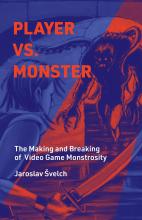
by Jaroslav Švelch
MIT PRESS, 2023, 240 PP.
HARDCOVER, $26.95 ISBN: 978-0-262-04775-3
The multifaceted arguments Jaroslav Švelch marshals in this study of monstrosity promise to address two pivotal issues: Why are monsters so prominent in gaming, and how has gaming changed our perception of monsters? These and other salient questions are tackled in Švelch’s circumspect and well-documented study from a range of angles. His study summarizes strands of monster research, assembles a canon of game monsters, discusses art historical and media historical trends in monster design and their representational conventions, and then sets out to profile games that subvert a dominant model that tends to make a hero of the monster killer. The takeaway notion at the end is that fictional creatures should not be reduced to expendable obstacles and stereotypes.
As the discipline of game studies deals with growing pains, it has yet to arrive at a coherent disciplinary identity and continues to draw on a host of academic domains. Teratology, or the study of monsters, is surely one of the older strands wound up in this formation and certainly one of the submerged legacies that fed fantastic literature, Dungeons and Dragons, and other obvious influences on game design. Here Švelch promises to go far beyond the usual summary invocations of Johan Huizinga and Roger Caillois or Richard Bartle and Gary Gygax, opting to cite Immanuel Kant and Julia Kristeva, Paul Edwards and Peter Galison, David Wengrow and Bruno Latour, among many others—a laudable opening of game studies to intellectual engagements that is also reflected in the fact that over a quarter of the book is devoted to notes and bibliography. The broad literature review offered in Švelch’s first chapter includes the aesthetics of the sublime and philosophies of transgression, medieval literature and poststructuralist theory, cultural studies and colonialism, Hollywood and Japanese popular culture, simulation and sociology. Listing these and related academic strands, Švelch declares his ambition first to “combine these disparate perspectives” and then to explore and question “some of the core design conventions of the video game medium” (5). Admittedly, the first part of this ambitious research design is hard to achieve, though Švelch comes rather close; the latter half is not delivered, however, because Švelch mostly neglects the technical genesis of gaming in favor of characters and plots, as if games were merely texts rather than highly technical interactions. Yes, Švelch’s dissection of titles such as Space Invaders (and of the daemon of computer networks) does consider certain technological constellations that led to computer gaming, but the project chooses not to pursue them far enough to give rise to interpretive claims about gaming. Nonetheless, this reader was pleased to see Švelch mention the Living Computer Museum in Seattle and other such institutions of cultural memory [End Page 105] that grant access to older hardware and software interactions; this aspect of gaming may deserve more attention, even in the context of a comparative study of gaming monsters.
While nobody will be surprised to see Švelch suggest that the computational and commodified otherness of gaming’s monsters essentially revolves around issues of race and gender, such cultural studies notions omit a crucial dimension that had long been prominent in the study of monsters. Bruno Bettelheim proposed in The Uses of Enchantment that ogres and giants and other fairytale monsters are in fact adults seen from a child’s perspective, mythologizing what adults do to children.1 No amount of interviews with expert players or sifting through online discussion will obviate a need to understand that undeniable legacy. The enduring appeal of monsters is not that they reduce others to obstacles, it is that they are coping mechanisms, though a psychological perspective is one of the plausible angles missing from Švelch’s book. Experts in this tradition have long held that we use dreams and myths to cope with the pressures of growing up and integrating our personalities. Seen this way, the answer to the question of how gaming has changed our perception of monsters may be: not as much as it may seem if one filters it through the reductive lens of race and gender. Game studies would do well to acknowledge the rich traditions not just of folklore and young adult fiction but also of many art forms that draw on the inexhaustibly deep repositories of teratology that continue to populate our fantasies. Švelch’s book points us in that direction.
—Peter Krapp, University of California, Irvine
- Bruno Bettelheim, The Uses of Enchantment (New York: Knopf, 1976).

